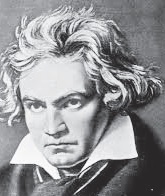REVIEW POTPOURRI: Beethoven’s 5 Piano Concertos
 by Peter Cates
by Peter Cates
Something a little different this week:
Beethoven’s 5 Piano Concertos were a very significant body of work because they both consolidated the best of what the composer learned from his predecessors — Haydn, Mozart etc. – and broke new ground on the expansion of the piano’s technical possibilities and musical depths. These two considerations, as edifying as they are, cannot be explored more, due to limited space. What will be done instead is to touch briefly on the merits of each Concerto and to offer one recording that is quite special in and of itself from the shelves of duplicates in my possession.

Ludwig von Beethoven
Concerto no. 1 has a jubilant yet graceful beauty in its assertive rhythms and rich melodic writing. A performance of exceptional quality is the mid-’50s, nicely transferred radio broadcast featuring Sviatoslav Richter, with the gifted but very unknown Bratislav Bakala on the podium, one not to be confused with later Richter releases conducted by Karel Ancerl and Charles Munch. The pianist’s often larger than life virtuosity found a captivating vehicle in this work while Bakala’s astute care for every note matched Richter’s own. A CD is available through Berkshire Record Outlet with the pair’s Beethoven 3rd.
Concerto no. 2, actually composed before the 1st but published after it, is very headstrong in its feisty exhuberance. Rudolf Serkin made three recordings; the first one, from the early ‘50s for Columbia and with Eugene Ormandy and the Philadelphia Orchestra, is my favorite of them. Serkin gave a headstrong performance and a very exciting one, both rhythmically and musically. It is available on a Sony CD through Amazon.
Concerto no. 3 is on a grander scale and one beautiful, powerful creation. The 1949 recording with the relatively unknown Eduard Erdmann and conductor Helmut Muller-Kray shows an especially eloquent, deeply moving understanding of its content. It is part of an inexpensive two-CD set on the historical Tahra label, also containing one of the Schubert Sonatas, and can be found via the above-mentioned Berkshire.
Concerto no. 4 is a masterpiece of sublime introspection. The 1962 collaboration between Van Cliburn and Fritz Reiner leading the Chicago Symphony was the result of several months worth of the most detailed preparation between the pianist and conductor and shows in the gripping performance available on a nicely remastered BMG CD, again available through Amazon.
Concerto no. 5, better known as the “Emperor,” was conceived on a heroic scale never before experienced in the piano repertoire. In addition, it may be the most frequently played of the five works in concert hall and recording studio, due to its very appealing musical scoring. One highly recommendable live performance from 1995 showcases the then 17-year-old Mihaela Ursuleasa, winner of first prize at the Clara Haskil competition in Switzerland, whose much too early 2012 death remains one inexplicable tragedy. Her rendition, with the late conductor, Jesus Lopez-Cobos, has a quality of newly-minted freshness and is a formidably distinctive entry among a large number of distinctive entries. The Claves CD contains a very engaging Mozart 9th Piano Concerto as its discmate and can be bought through Amazon.
Pianist Wilhelm Kempff considered these five Concertos inexhaustibly rewarding for both performer and listener!
Responsible journalism is hard work!
It is also expensive!
If you enjoy reading The Town Line and the good news we bring you each week, would you consider a donation to help us continue the work we’re doing?
The Town Line is a 501(c)(3) nonprofit private foundation, and all donations are tax deductible under the Internal Revenue Service code.
To help, please visit our online donation page or mail a check payable to The Town Line, PO Box 89, South China, ME 04358. Your contribution is appreciated!


Leave a Reply
Want to join the discussion?Feel free to contribute!